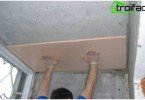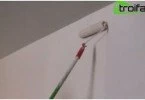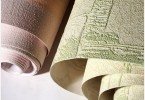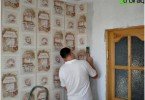How to insulate a wall in an apartment
Unfortunately, the level of thermal insulation in Soviet-built houses is by no means satisfactory. This leads not only to problems with heating homes in the winter, but also to such troubles as the occurrence of fungus and mold. If the walls “bloomed”, neither antifungal agents nor cosmetic repairs will help – sooner or later the mold will return. The only way to get rid of this scourge forever is wall insulation. The choice of thermal insulation materials on the shelves of construction stores is quite large. You can use almost any of them. It remains only to decide how insulate the wall in an apartment – inside or out.
Content
- Is it possible to insulate the outside?
- Insulation of the walls of the apartment from the inside
- Competent selection of materials
- Preparing the wall for insulation
- Mineral wool insulation technology
- The procedure for attaching the foam
Is it possible to insulate the outside?
Insulating walls from the outside is, of course, much more effective than from the inside. In order to find out why this is so, you need to consider such a thing as “dew point”.
The “dew point” is the ambient temperature at which water vapor in the air condenses.
In a wall insulated from the outside, the “dew point” is most often located either in the thickness of the insulation, or between the insulating material and the wall, and, therefore, the inner surface of the wall always remains dry. If the insulating material is laid inside, then with a sharp drop in temperature, the dew point can be between the wall and the insulation, which will inevitably lead to condensation. The surface of the insulation will remain dry, but under it the growth of the fungus will begin. As a result – dampness and smell of mold in the apartment.
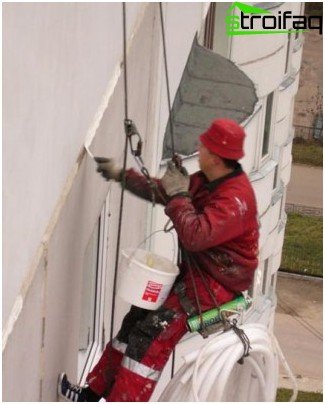
External wall insulation using industrial mountaineering
In multi-storey buildings, to insulate the walls outside, you will have to hire a team of industrial climbers, which is quite expensive.
Oddly enough, the housing company may be another barrier to warm and dry walls. In some cities, partial insulation of the facades (walls of one apartment) is prohibited.
Insulation of the walls of the apartment from the inside
If the only way out for you is to lay insulating materials inside the apartment, you need to try to do it right. To start, we choose a heater.
Competent selection of materials
Despite the variety of heat-insulating materials, the most popular are mineral wool and polystyrene (regular or high density – EPS). Both have advantages and disadvantages. Having a sufficiently low thermal conductivity, the foam could become an ideal insulation if it were not for its ability to emit chemical elements harmful to health during operation. In addition, this material is not sufficiently flame retardant. But the foam is not afraid of moisture. But mineral wool does not burn, but with increasing humidity, its thermal conductivity increases significantly. And the service life of this material is much shorter than that of a “competitor” – it cakes with time.
Preparing the wall for insulation
Whatever material you choose, you must first carefully prepare the wall. To do this, remove the wallpaper and treat the surface with a primer. If there are cracks in the wall, blow them with foam.
Mineral wool insulation technology
Installation of mineral wool provides for further wall decoration with drywall. Despite the fact that after installation this material is absolutely safe, work must be done in a respirator or mask.
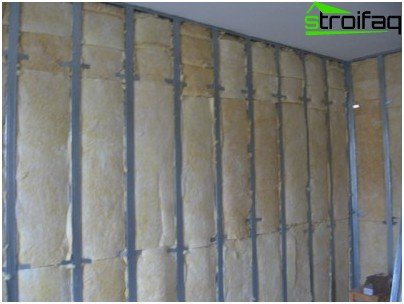
Internal wall insulation with mineral wool
First you need to build a frame of metal profiles for attaching drywall.
Then lay the mineral wool and be sure to cover it with a vapor barrier film. This is necessary to protect the insulation from moisture. Now it remains only to attach drywall.
The procedure for attaching the foam
The installation of polystyrene or EPS is the simplest. On the prepared surface using adhesive for drywall or acrylic putty, you need to attach foam sheets.
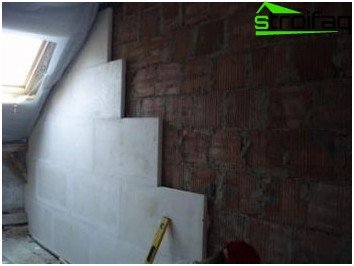
The procedure for attaching the foam
Apply the adhesive should not be on the entire surface of the sheet, but only in the corners and in the center. And by adjusting the thickness of its layer, you can fix the curvature of the wall. It is advisable to install the sheets in a “staggered” order and after drying the glue additionally fix them with dowels. When the wall is fully pasted, the gaps between the sheets must be filled with sealant or polyurethane foam. Such a wall can not be sheathed with drywall, just enough to putty it.
In addition to the possibility of accumulation of condensate, wall insulation from the inside has another significant drawback – a decrease in usable area. In addition, you will have to constantly monitor the ventilation of the room, and if the ventilation system is not in order or completely absent, regularly ventilate it. So to carry out such work is necessary only in the case when insulation from the outside is absolutely impossible.


